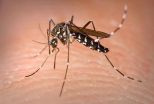(Press-News.org) A new Canadian guideline recommends that the prostate-specific antigen (PSA) test should not be used to screen for prostate cancer based on evidence that shows an increased risk of harm and uncertain benefits. The guideline is published in CMAJ (Canadian Medical Association Journal)
"Some people believe men should be screened for prostate cancer with the PSA test but the evidence indicates otherwise," states Dr. Neil Bell, member of the Canadian Task Force on Preventive Health Care and chair of the prostate cancer guideline working group. "These recommendations balance the possible benefits of PSA screening with the potential harms of false positives, overdiagnosis and treatment of prostate cancer."
For men with prostate cancer diagnosed through PSA screening, between 11.3% and 19.8% will receive a false-positive diagnosis, and 40% to 56% will be affected by overdiagnosis leading to invasive treatment. Treatment such as surgery can cause postoperative complications, such as infection (in 11% to 21% of men), urinary incontinence (in up to 17.8%), erectile dysfunction (23.4%) and other complications.
Prostate cancer is the most commonly diagnosed non-skin cancer in men and the third most common cause of death from cancer in men in Canada. However, the prognosis for most prostate cancers is good with a 10-year survival rate of 95%. Prostate cancer is generally slow to progress and usually not life-threatening.
The guideline, aimed at physicians, other health care professionals and policymakers, contains prostate cancer screening recommendations for using the PSA test with or without manual rectal examination of men in the general population. Based on the latest evidence and international best practices, the guideline updates the previous version published by the task force in 1994.
Key recommendations:
For men under age 55 and over age 70, the task force recommends not using the PSA test to screen for prostate cancer. This strong recommendation is based on the lack of clear evidence that screening with the PSA test reduces mortality and on the evidence of increased risk of harm.
For men aged 55–69 years, the task force also recommends not screening, although it recognizes that some men may place high value on the small potential reduction in the risk of death and suggests that physicians should discuss the benefits and harms with these patients.
These recommendations apply to men considered high risk — black men and those with a family history of prostate cancer — because the evidence does not indicate that the benefits and harms of screening are different for this group.
"Any use of PSA testing to screen for prostate cancer requires a thoughtful discussion between the clinician and the patient about the balance between unclear benefits and substantial harms," states Dr. James Dickinson, member of the prostate cancer guideline working group.
The guidelines are consistent with the recommendations of the US Preventive Services Task Force and the Cancer Council Australia. The United Kingdom does not have an organized screening program but recommends that men concerned about the risk of prostate cancer receive balanced information on the benefits and harms of screening.
The task force recommendations are based on systematic evidence reviews and use an international framework for assessing quality of evidence and the strength of recommendations for clinical guidelines (GRADE).
To help patients and their physicians make informed decisions, the task force has created tools to help patients and physicians in decision-making about testing. Visit http://www.canadiantaskforce.ca.
The Canadian Task Force on Preventive Health Care has been established to develop clinical practice guidelines that support primary care providers in delivering preventive health care. The mandate of the task force is to develop and disseminate clinical practice guidelines for primary and preventive care, based on systematic analysis of scientific evidence.
"The task force's guideline is an excellent example of health care decisions being made from the perspective of evidence-based medicine," writes Dr. Murray Krahn, University Health Network and University of Toronto, Toronto, Ontario, in a related commentary. "However, it paid insufficient attention to patient values, patient preferences and costs."
"The task force's guideline provides a good summary of the data on the effectiveness of prostate cancer screening and a reasonable review of the rate at which potential harms occur," he states. However, several elements could provide more complete information for making decisions. These include a comprehensive review of patient harms, a review of modelling studies, evidence on cost as well as more on patient preference and shared decision-making, of which there is substantial literature.
Dr. Krahn suggests that recommendations for clinical practice should be based on patient preferences, social values and health care costs in addition to evidence on outcomes.
"The falling overall mortality in some countries that screen intensively [for prostate cancer], the evidence that treatment may have a very modest disease-specific mortality benefit, and the highly variable preferences for treatment outcomes suggest to me that we should not push patients out of decision-making in this area," concludes Dr. Krahn.
INFORMATION:
The team of researchers, led by Dr Rafael Carazo Salas from the Department of Genetics, combined high-resolution 3D confocal microscopy and computer-automated analysis of the images to survey the fission yeast genome with respect to three key cellular processes simultaneously: cell shape, microtubule organisation and cell cycle progression. Microtubules are small, tube-like structures which help cells divide and give them their structure.
Of the 262 genes whose functions the team report in a study published today in the journal Developmental Cell, two-thirds are linked ...
ity of Industry, CA – October 28, 2014 – A new randomized controlled trial (RCT) of post-menopausal women demonstrates that a proprietary blend of collagen and calcium, KoACT®, was far superior to calcium and vitamin D in slowing down the leaching of calcium from bones and rebuilding new bone strength. An Abstract of the article appears on PubMed at: http://www.ncbi.nlm.nih.gov/pubmed/25314004, ahead of print in The Journal of Medicinal Food.
The research was conducted by Bahram H. Arjmandi, PhD, RDN, who is currently Margaret A. Sitton Named Professor ...
WASHINGTON (Oct. 27, 2014) — Recent breakthroughs may pave the way for vaccines and new drugs for those infected by parasitic helminths. These flatworms, including tapeworms that cause hydatid diseases and neurocysticercosis, liver flukes, and blood flukes (schistosomes), infect more than 300 million people and cause approximately four million disability-adjusted life years lost due to chronic illness and death each year.
Paul Brindley, Ph.D., professor of microbiology, immunology, and tropical medicine, and scientific director of the Research Center for Neglected ...
In the on-going effort to develop advanced biofuels as a clean, green and sustainable source of liquid transportation fuels, researchers at the U.S. Department of Energy (DOE)'s Joint BioEnergy Institute (JBEI) have identified microbial genes that can improve both the tolerance and the production of biogasoline in engineered strains of Escherichia coli.
Aindrila Mukhopadhyay, a chemist who directs the host engineering program for JBEI's Fuels Synthesis Division, led a study in which transcriptomic data and a synthetic metabolic pathway were used to identify several genes ...
NASA's Terra satellite spotted a "zombie" tropical storm as Halloween week kicks off. Tropical Depression 9 made landfall in Mexico's Yucatan Peninsula late last week and lingered as a remnant low pressure area on Saturday and Sunday, Oct. 25 and 26. Satellite data revealed that those remnants had reformed quickly and jumped up to tropical storm status, where it became "zombie" storm named Tropical Storm Hanna off the coast of Nicaragua. NASA's Terra satellite spotted strong thunderstorms around the zombie storm's center as it passed overhead.
At 9:30 a.m. EDT on Oct. ...
Using ultrasound technology to visualize the tongue's shape and movement can help children with difficulty pronouncing "r" sounds, according to a small study by NYU's Steinhardt School of Culture, Education, and Human Development and Montclair State University.
The ultrasound intervention was effective when individuals were allowed to make different shapes with their tongue in order to produce the "r" sound, rather than being instructed to make a specific shape. The findings appear online in the Journal of Speech, Language, and Hearing Research.
The "r" sound is one ...
Difficulty in conceiving a child is a major challenge for one in seven heterosexual couples in America, especially for those over the age of 35. Now a new discovery by researchers at Tel Aviv University and Chaim Sheba Medical Center at Tel Hashomer could boost the chances of conception in women undergoing in vitro fertilization (IVF) treatments.
Their new research reveals a linkage between the genes of the innate immune system — immunity with which human beings are born, rather than immunity they acquire during their lives — and ovarian longevity. The study, ...
Rice University researchers have delivered a scientific one-two punch with a pair of papers that detail how synthetic collagen fibers self-assemble via their sticky ends.
Collagen is the most common protein in mammals, a major component of bone and the fibrous tissues that support cells and hold organs together. Discovering its secrets may lead to better synthetic collagen for tissue engineering and cosmetic and reconstructive medicine.
The Rice lab of Jeffrey Hartgerink has been studying synthetic collagen for a decade, teasing out the details of how it starts as three ...
The Asian tiger mosquito (Aedes albopictus), which is native to Southeast Asia, was spotted in Houston in 1985. By 1986 it had reached St. Louis and Jacksonville, Fla. Today it can be found in all of the southern states and as far north as Maine.
An aggressive daytime biter, Ae. albopictus has an affinity for humans and is also a vector for human disease, said Kim Medley, PhD, interim director of the Tyson Research Center at Washington University in St. Louis.
The mosquito arrived in the U.S. in a shipment of used tires from Japan. Ae. albopictus lays eggs that can ...
Adélie penguins are an indigenous species of the West Antarctic Peninsula (WAP), one of the most rapidly warming areas on Earth. Since 1950, the average annual temperature in the Antarctic Peninsula has increased 2 degrees Celsius on average, and 6 degrees Celsius during winter.
As the WAP climate warms, it is changing from a dry, polar system to a warmer, sub-polar system with more rain.
University of Delaware oceanographers recently reported a connection between local weather conditions and the weight of Adélie penguin chicks in an article in Marine Ecology ...





